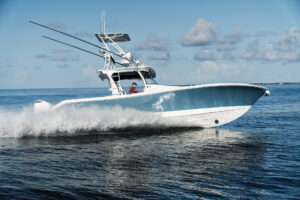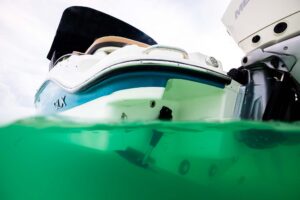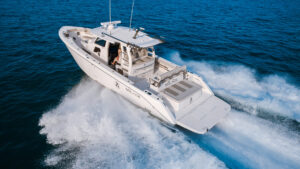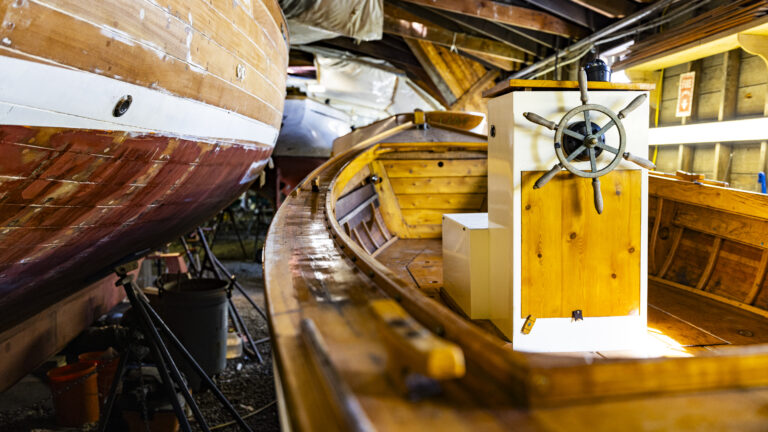You don’t always have the luxury of a skilled crew when it’s time to get the boat on or off the dock. Sometimes you’re doing it with just one other person, or maybe you’re boating alone. It’s especially tricky when you, the skipper, serve as a deckhand. Who is driving the boat if you’re on the stern, fending off, or hauling in a line?
If you have a wireless remote docking control, it will be you.
A wireless remote docking control is about the size of your TV remote and will let you manipulate your shifts, throttles, thruster(s), the windlass and even the horn, from anywhere on the boat. Remotes can even have a joystick. You can stand in the cockpit or on the side deck, hold the boat alongside while someone retrieves the dock lines and then gently ease off the dock. You’ll also be able to haul those fenders in and look shipshape, too.
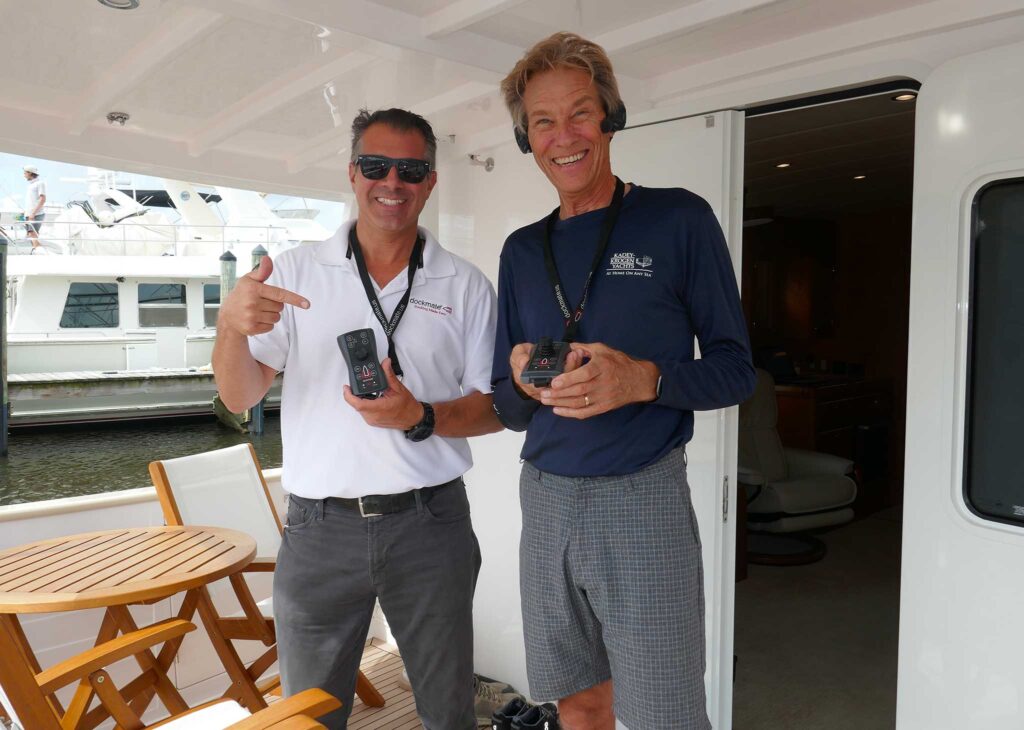
How good are these wireless remote docking controls? Boating writer and educator Bob Arrington installed one of the first Dockmate systems in the U.S. on his 54-foot, twin-screw Ocean Alexander, Liberdade. Initially, he thought it was a bit pricey and possibly unnecessary. Now he says, “you couldn’t pry it out of my hands.” Arrington says Dockmate has made handling the boat with just his wife, Dori, easier and, more important, much safer. “They should really call it ‘SafetyMate,” he says.
Jeff Hall agrees. Hall and his wife, Ellen, live aboard Sea Dweller, a Kadey-Krogen 48AE with a single John Deere diesel and hydraulic bow and stern thrusters. Even with thrusters, maneuvering a single-screw boat like the Kadey-Krogen, with its high bow and lots of windage, can be tricky. So is picking up a mooring when you can’t see the ball from the helm. Remote wireless control makes it easier, says Hall, especially with just the two of them aboard. His Dockmate system “pays for itself in reduced anxiety—and in not making the insurance companies rich,” he says.
Both Arrington and Hall own Dockmate wireless remote docking controls, a popular system on the market. Another is Yacht Controller, which came to the U.S. in 2003, about 15 years before Dockmate.
Dockmate and Yacht Controller manufacture their components in Switzerland and Belgium, respectively. They are the only two wireless remote docking systems in the U.S. Both systems do the job, both have more functions than you need, both will make close-quarters maneuvering easier and safer.
Wireless control doesn’t replace or modify your ship’s controls. The wireless remote is just an auxiliary means of operation, via a master control unit that mounts near the helm. The master connects, either by direct plug-in or the boat’s CANbus backbone, to the engine, thruster and windlass controls. Installation on older boats with mechanical controls will also require a servo on each transmission, connected to a short shift cable; in this case, the remote won’t include throttle control. The master receives instructions from the remote which, when not needed, lives in a recharging cradle at the helm. You can choose a remote with buttons and rocker switches, or buttons and a joystick.
The remote communicates with the master by using spread spectrum frequency hopping (FHSS) to minimize the chance of interference from any of the other wireless signals flying around. The remote and master are synchronized so they’re always on the same frequency, and the hopping is so frequent that the chance of crossed signals with another transmitter is virtually nil.
Yacht Controller also uses FHSS on two bands simultaneously, so if one band is blocked, or the signal is degraded, communication is maintained on the other band. The company’s Dual Band technology has been tested and certified by the International Electrotechnical Commission to meet the requirements of standard EN 60945 Maritime Navigational Apparatus. This certification approves the Dual Band Yacht Controller for use on government, passenger and commercial vessels in more than 160 countries, including the U.S., Canada and the EU. No other wireless remote control has this certification.
Wireless remote docking controls don’t give you docking skills. They’re not automatic docking systems, like those from Volvo Penta and Raymarine, which use sensors, cameras and electronic brains to prevent collisions. A wireless remote system still requires boat-handling skills. Inept boat handlers with remote controls can still bash into docks as if they are steering from the helm. But a competent skipper can move to spot where the sightlines are cleaner and thus make docking easier and safer. A wireless remote system with joystick control lets the skipper move the boat with one finger rather than having to use both hands to manipulate rocker switches and buttons. Based on the joystick input, the docking system will adjust throttles, shifts and thrusters to move the boat in the desired direction.
Whether you choose Dockmate or Yacht Controller, the system will be custom engineered for your boat. Installation is usually straightforward, although it must be done by a qualified, company-trained technician who is up to date on the latest hardware and software.
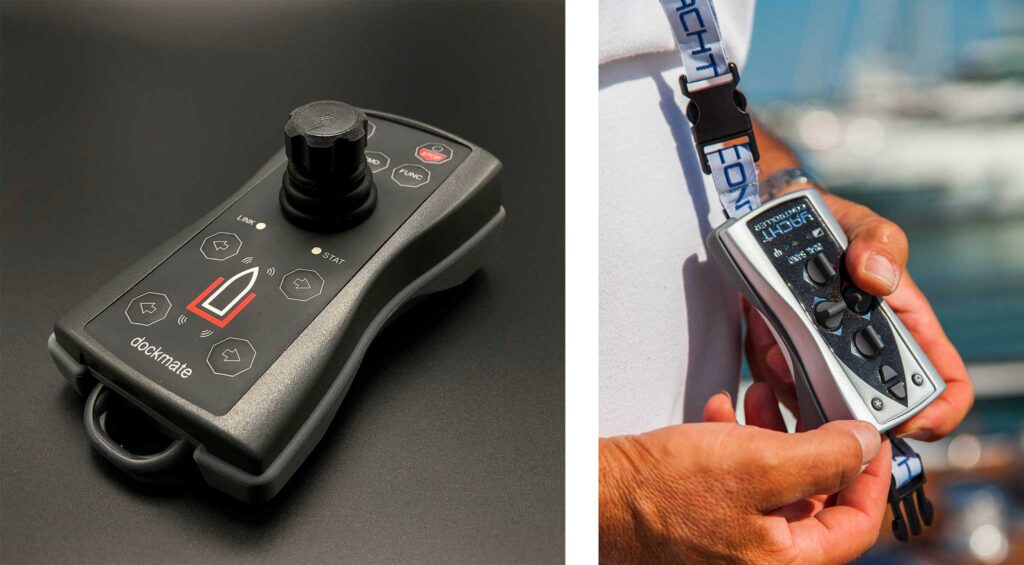
If your Dockmate needs a software update, or you want to change how the wireless remote interacts with your ship’s controls, Dockmate will send a tech to make the changes and do a sea trial with you. If you want the controller to ramp up engine speed more quickly or use a higher percentage of full throttle before capping the rpm, that can be done.
Yacht Controller handles its software adjustments remotely over the internet via a VPN (virtual private network) that creates an encrypted connection for security. All you need is a solid WiFi connection and the ID number of your master controller. You do a sea trial, then call Yacht Controller back if more fine-tuning is needed.
There are a lot of software programming variables available. Some fishermen want to program the Stern Trick into their Dockmates. Most twin-screw sportfishing boats split shifts to spin the boat, one engine in forward, one in reverse. Not many of these boats have stern thrusters. But a Dockmate technician can program the stern-thruster buttons on a Dockmate control to do this automatically. Want to spin the stern to port, for example, to point at a fish? Hit the port stern thruster button, and the Dockmate software will shift the transmissions appropriately and the boat will act like it has a stern thruster.
Yacht Controller can program up to five profiles on one wireless remote. So, if the boat’s operated by different captains, each one can have his preferred remote docking set-up. Maybe dad likes the relaxed approach, but the kids like to use a bit more horsepower. Or maybe a de-tuned approach is safer when teaching the kids how to handle the boat. Switching between profiles requires just hitting a button.
When John Doyle bought his Axopar 45 XC last year, he added Dockmate wireless remote docking, despite having a factory-installed joystick control for his triple Mercury 300-hp Verado outboards. “It was a last-minute purchase,” said Doyle, “and I’ve been blown away with the ease of use and the advantages it provides.”
Dockmate does more than the joystick, he added. “You can adjust relative speed while docking, sound the horn, control the bow thrusters and the windlass.” Doyle said being able to leave the helm and take the joystick anywhere on the boat was “incredibly convenient” for tight anchoring and docking situations. “It was also extremely helpful when my wife and I were going through the many locks on the Erie Canal. The Axopar is an easy boat to handle, but the Dockmate takes this to another level.”
So how much does this cost? Both Yacht Controller and Dockmate will work out a precise number for you if you contact the companies through their websites, but figure on spending somewhere in the low five figures for a fully featured system. If you don’t have a bow thruster, you’ll want to add one. Sure, it sounds expensive, but so is hitting something. Smash your teak swim platform into a piling or whack a megayacht that just got a new Awlgrip job and you’ll wonder why you waited so long to add wireless remote control docking to your boat.
This story was published in the July 2025 issue



